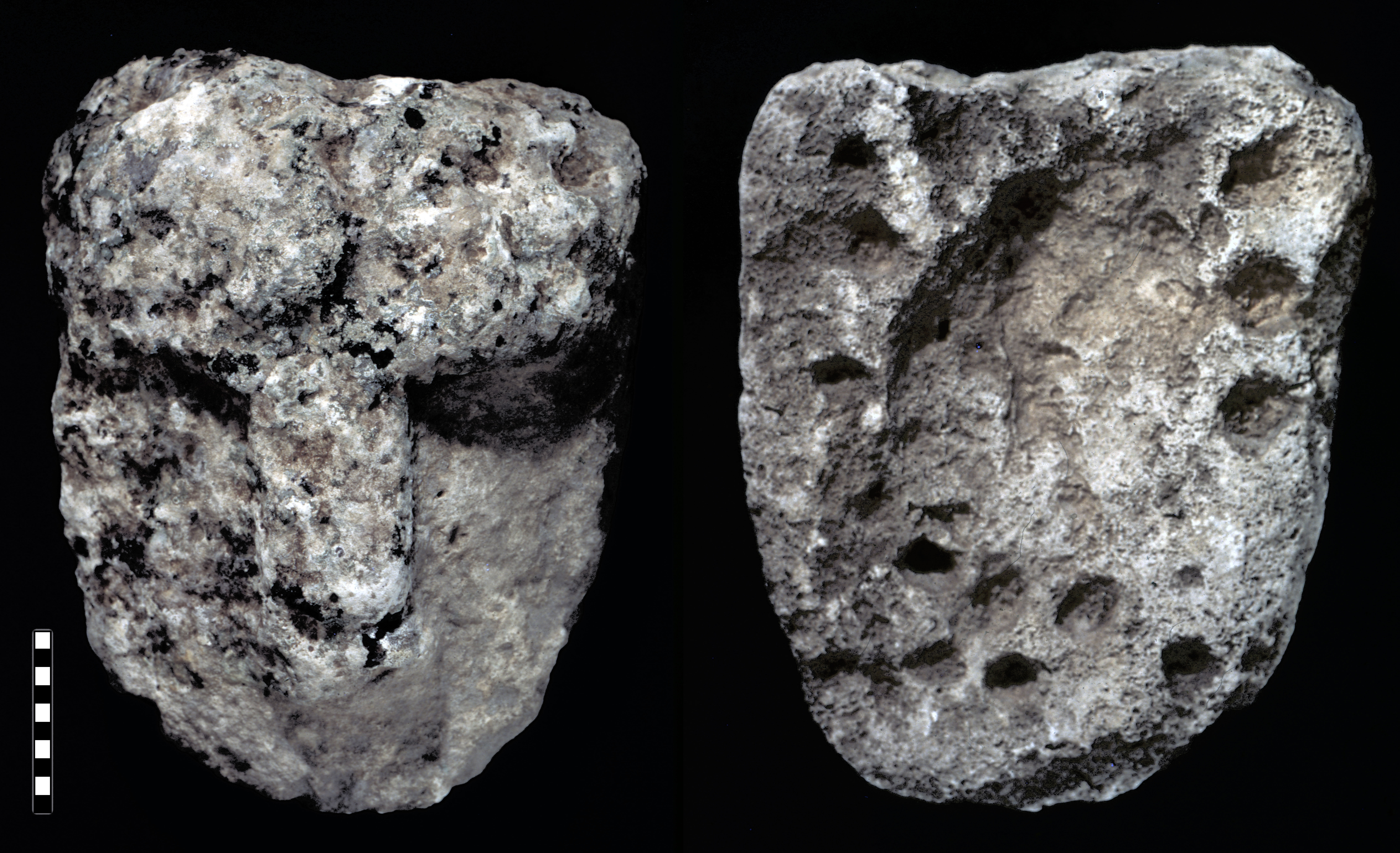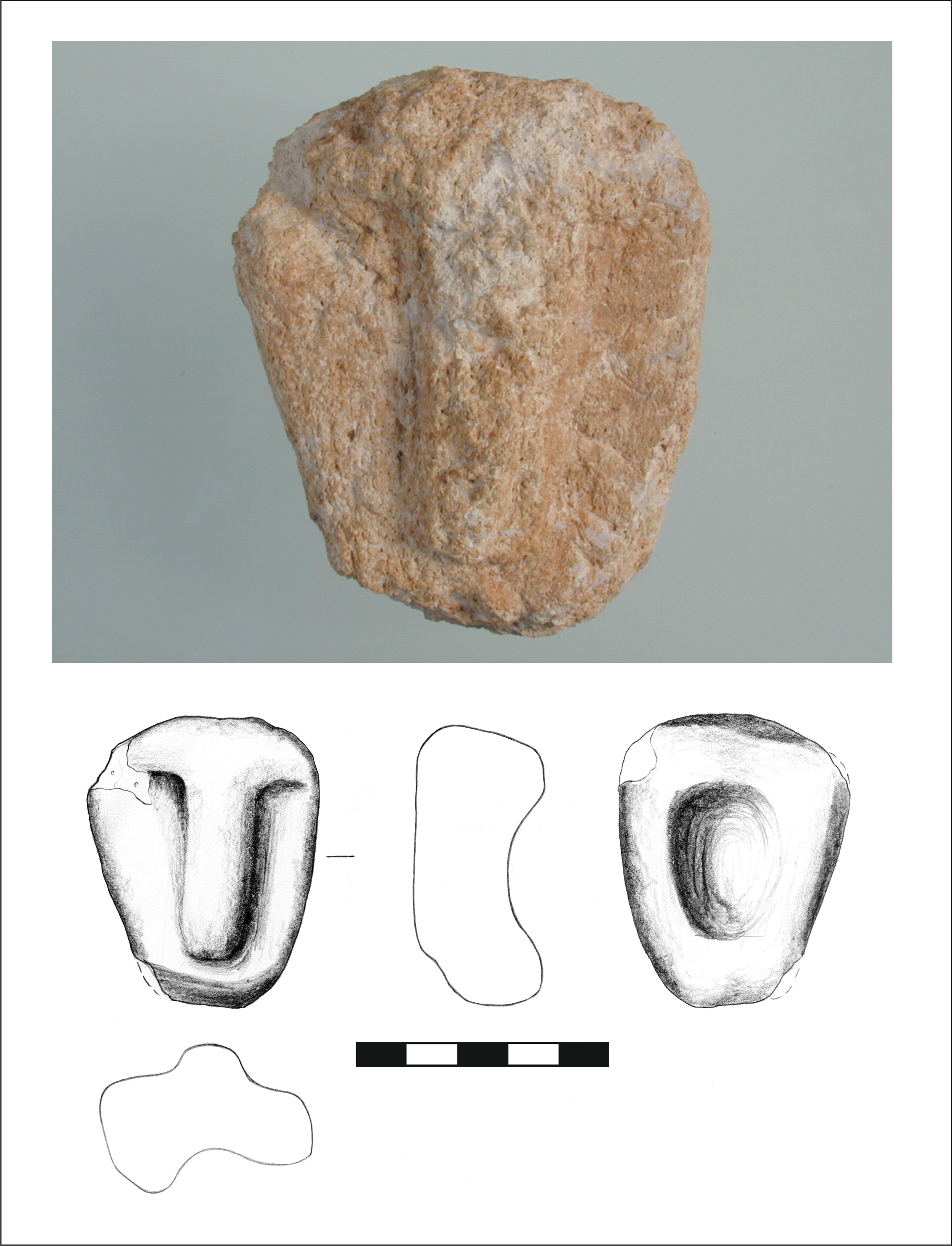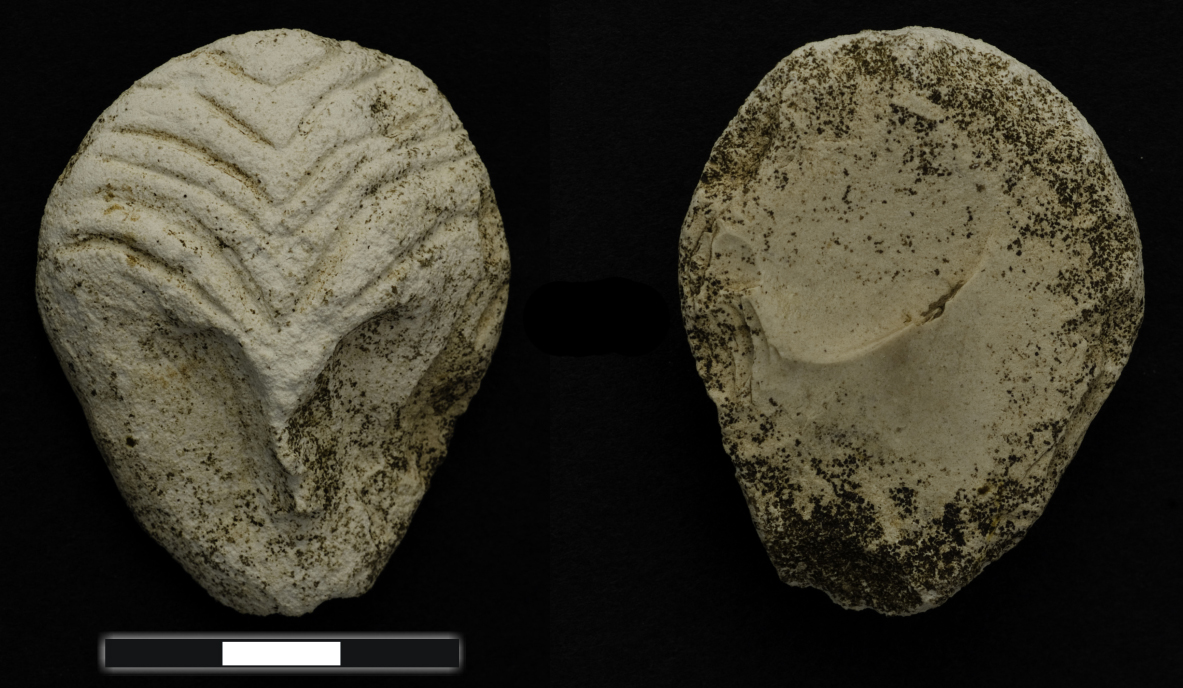(A longer and more extensive version of this text was originally published recently: O. Dietrich, J. Notroff, L. Dietrich, Masks and Masquerade in the Early Neolithic: A view from Upper Mesopotamia, Time and Mind 11:1, 2018, 3-21 [external link].)
Among early prehistoric masks, those from the Judean Hills and Desert [external link] can be considered the most prominent examples. These masks, made of stone and weighing up to approximately 2 kg, strike the modern observer with their almost expressionistic facial features – each is individual, as if depicting specific individuals or beings. Some have holes around the rim, probably to allow attaching them to something, or to actually wear them (although they are fairly heavy). Chronologically, the oldest of these Southern Levantine masks belong to the Pre-Pottery-Neolithic B, i.e. the mid 9th and 8th millennia BC. Since specimens excavated in the Nahal Hemar cave (Israel) in the early 1980s were found within an assemblage interpreted as ‘cultic’ a ritual use of these masks was assumed (Bar Yosef & Alon 1988). The Southern Levantine examples are special and important, but not unique in their period. Within the rich repertoire of sculpture from several contemporary sites in this region, a few artefacts with concave or flat rear backs stand out that could be interpreted as depitions of masks.

Figure 1: Miniature mask from Nevalı Çori (Drawing: K. Schmidt, courtesy of H. Hauptmann).
From Jerf el Ahmar, a PPNA A/transition to PPN B site in northern Syria (characterised by round and rectangular buildings with limestone foundations) two little stone heads are reported which show a conspicuous concave cavity on their backside (Jammous & Stordeur 1999; Stordeur & Abbès 2002). They are made from pebbles, only about 4 cm high and show eyes, a nose, and mouth. The backside of one of these objetcs is grooved, the other one concave. Another miniature stone mask of similar size is known from Nevalı Çori (Figure 1) in southeastern Turkey (Badisches Landesmuseum 2007, 292, nr. 110, Fig. 110; Hauptmann 2011, Fig. 17). Again eyes, nose, and mouth are depicted, the back is concave. From its find context, a middle-PPN B date can be assumed for this mask. Nevalı Çori furthermore has become well known as the first place there a characteristic element of PPN architecture of the region was discovered: T-shaped, apparently anthropomorphic, pillars which link it to another site nearby which also has produced a number of comparable masks: Göbekli Tepe.

Figure 2: Larger than life-sized mask from Göbekli Tepe (Photo: K. Schmidt, DAI).
A first, larger than life-sized (height: 42 cm) and complete human mask (Figure 2) made from limestone was found during clearance work before beginning of excavations in 1995 (Schmidt 1996: 2-3, Fig. 1). The depiction of the face is minimalistic, almost abstract. They eyes are very faint and the mouth is absent. Forehead and nose are carved in a geometrical manner, almost resembling a ‘T’. This manner of portraying the human face is characteristic also for three-dimensional anthropomorphic sculpture at Göbekli Tepe and thus a clear indicator that a human face is depicted here. Due to its height it seems too large to be actually worn, but could have been intended to be fixed to a wall or another kind of support.

Figure 3: Miniature mask from Göbekli Tepe (Photo: K. Schmidt, Drawing: Ç. Köksal-Schmidt, DAI).
The second example is another miniature (height: 5.7 cm), also made from limestone (Badisches Landesmuseum 2007: 275, No. 29, Fig. 29). It was found in the upper layers of the filling of Enclosure D in 2001 (Figure 3). With a concave rear like the specimen reported from Nevalı Çori, it follows the same minimalistic principle as the large mask from Göbekli Tepe. Again, it is clear that a human face is depicted, but individual characteristics are not given. The eyes are not even suggested here, a mouth is absent again.

Figure 4: Miniature mask from Göbekli Tepe, made from a flint cortex (Photo: N. Becker, DAI).
The third mask, a miniature again (height: 4.7 cm) is of a different type (Figure 4). Not only was it made from a flint cortex, it also is much more expressive, due to curved chevrons engraved into its forehead, not unlike the mask from Jerf el Ahmar discussed above. This may indicate a headdress, but the fairly low setting of the lines could also hint at tattooing or scarification. The back was not finished. This mask was found in 2010, high in the stratigraphy, during excavations in Enclosure H, next to (central) Pillar 51.

Figure 5: Miniature mask from Göbekli Tepe, engraved in a flint cortex (Photo: K. Schmidt, DAI).
A fourth miniature (height: 4.5 cm high) of a mask was also engraved into a flint cortex (Figure 5). Its form follows the reduced depiction of the face of the first two examples again, with more pronounced eyes. It was found in 2008 next to the eastern central pillar of Enclosure C.
While the first mask can only broadly be dated to the PPN as a surface find, the second mask from the filling of Enclosure D could indicate a PPN A date, as could the miniature mask from Enclosure C, with its position nearby one of the central pillars. Enclosure C has been damaged and disturbed in prehistory by a large pit directed at the central pillars, but the mask seems to come from an untouched floor layer. The third mask was found next to a central pillar of Enclosure H. The stone circle was also damaged and disturbed in prehistory already.
Three of the masks found at Göbekli Tepe have undoubtedly a similar style to the example from Nevalı Çori. They show non-individualized faces. However, at Göbekli Tepe the mouth is not depicted, while the Nevalı Çori mask almost gives the impression of a screaming face. Together with the finds from other sites, a large repertoire of masks in different styles is suggested. All types, with and without mouth, more individualized or abstract, are also well attested for in the large repertoire of limestone sculpture found at Göbekli Tepe (Figure 6). Their treatment during the refilling events can shed some light on aspects of the use of masks during the PPN at this site.

Figure 6: Selection of limestone heads from Göbekli Tepe, not to scale (Photos: N. Becker, D. Johannes, K. Schmidt, DAI).
Burial rites at Göbekli Tepe seem to have been applied to a part of a hierarchical system of anthropomorphic depictions. The enclosures’ central pillars are abstracted and clearly characterized as anthropomorphic. The surrounding pillars are also stylized, but smaller and contain zoomorphic decoration. They are orientated towards the central pillars and evoke the association of a gathering. Naturalistic anthropomorphic sculpture, which may partly depict masked people, is smaller and intentionally fragmented. The stone masks are strongly related to this category through form and deposition treatment. During backfilling of the enclosures, a selection of fragments, mostly (masked?) heads, and complete masks, was placed inside the filling, most often near the central pillars. If we assume that the stone masks are miniature or supra-sized representations of real organic masks actually worn, they could well attest that ritual activity at Göbekli Tepe and other sites included masquerade to the point where people became an active part within this complex mythology.
During the early Neolithic in the Near East, masks and masking possessed a significant role in rituals re-enacting mythological narratives closely related to death, taking place at sites with special purpose buildings and a noticeably rich iconography. This importance apparently justified the time-consuming and complicated manufacture of these praraphernalia as well as miniature and larger-than-life-sized representations of these items. A small amount of possible mask depictions in stone are all what remains of a presumably manifold Early Neolithic tradition of ritual masquerade.
References
Badisches Landesmuseum (ed.), Vor 12.000 Jahren in Anatolien. Die ältesten Monumente der Menschheit, Stuttgart 2007.
Bar Yosef, O. and Alon, D., Nahal Hemar Cave, ‘Atiqot 18, 1988, 1-81.
Hauptmann, H., The Urfa Region, in: Özdoğan, M., Başgelen, N., Kuniholm, P. (eds.), The Neolithic in Turkey 2. The Euphrates Basin, Istanbul 2011, 85-138.
Jammous, B. and Stordeur, D., Jerf el-Ahmar: un site Mureybetien du moyen Euphrate Syrien, horizon PPNA – Xe millénaire avant JC, in: del Olmo-Lete, G. and Montero Fenollós, J.-L. (eds.), Archaeology of the Upper Syrian Euphrates, the Tishrin Dam Areas, Barcelona 1999, 57-69.
Schmidt, K., The Urfa Project 1996, Neo-Lithics 2, 1996, 2-3.
Schmidt, K., Göbekli Tepe: A Stone Age Sanctuary in south-eastern Anatolia, Berlin 2012.
Stordeur, D. and Abbès, F., Du PPNA au PPNB: mise en lumière d´une phase transition à Jerf el Ahmar (Syrie), Bulletin de la Société Préhistorique Française 99 (3), 2002, 563-595.
Dear Jens,
Many, many thanks for your many inspiring, intriguing articles! You keep me searching out a lot of issues I never knew existed before reading your blog.
The holes in the back of your “larger than life-sized mask” are intriguing, as if it was afixed to something soft that would give it hold when hardening, like, erm, clay or plaster?
Your mention of the miniature masks in your article prompted me to ask about an issue I’ve been long wanting to ask: Incidentally, I am currently reading the exhibition catalogue “Vor 12.000 Jahren in Anatolien. Die ältesten Monumente der Menschheit” where it is mentioned that many miniature T-pillars were apparently found at Göbekli Tepe.
I know, it is very iffy to make assumptions from a 21st-century perspective, but your article seems to cry out for an answer to the correspondence between larger-than-life masks vs miniature masks and ‘larger-than-life’/life-size pillars vs miniature pillars.
Do you have anything in the pipeline on the miniature pillars, their context etc.?
My best wishes, Claas
Thanks a lot for your kind words. Yes, there are a couple of ‘miniature’ T-pillars as well (from Göbekli Tepe, but also Nevali Cori for instance) and we are currently, step by step, processing this material too. There will be more publications over time, but I cannot give any exact date yet, I’m afraid.
In regard to the large and small masks. Size in ancient depicted sign language represented relative importance as well as comparative physical size. Thus a Large (great) Face, his great appearance (the way he looks). Of course, one has to consider the context of the composition’s message.
In many ancient cultures the Sun was considered the greatest male-spirit. Because the “Eye of the Sun” a metaphor referring to Venus was the ultimate destination of deceased warrior-leaders it was described as, the little one his Face, the smaller one, his appearance. Sometimes the imagery of a Mouse was used to signify, small size. The “T” shaped gesture sign for, below, was superimposed over the area of the Eyebrows and Nose of the Face, in effect alluding to them. This would position the Eyes below the Eyebrows and to the sides of the Nose. In ancient sign language the Left and Right referred to the east and west and the other directions were established from this basic orientation. Because the Eyes were not depicted they were, in effect, not visible. The overall meaning would then become, the smaller one, (Venus) his appearance, below, and not in view.
Considering the above I would not consider all stone depictions of Faces as masks. Actually, even in rituals, masks were probably used to depict the different Faces, of spirit-entities or spirit essences that were used to create meaningful phrases. For example, a “pageant” might be created about the ancestors, A mask of a Snail would be used to express the spirit essence of, the one who moves slowly, The figure playing that part would use a staff as a support moving the staff in a revolving motion that was the gesture sign for, old, indicating aged. Thus as a compound sign, the old one moving slowly.
Would anybody really wear a mask of stone when wood or clay could be used? Those are head effigies / rock art, made by early man since the begining of time. They are all over the world. I have hundreds of them ranging from less than a inch in diameter and weighing almost nothing, to 18 inches wide and 40 lbs. Eaely man also carved depictions of animals. They also can be found around the world. Anything from a mammoth to a mouse to armadillo.
The stone ‘masks’ do not necessarily have to been worn by people (although at least many of the examples known from the Southern Levant (Nahal Hemar etc. pp.) show wholes around the rim hinting at an earlier attachment), but maybe by cult images, sculpture, the T-pillars in case of Göbekli Tepe etc.
However, as we have tried to emphasise in this article, the depiction of masks to scale (noteworthily differing from the also known limestone sculpture heads due to their concave back) indeed hints at the existence of similar objects among ritual paraphernalia made from organic material like e.g. wood.
If I have understood this correctly,where the masks/ and statuary were found in the stratigraphy of the site (ie not as old as the T Pillars) suggests that were not made/in use at the same time as the relief carvings found on the T pillars. I am struck by the lack of detail in the masks/heads as compared to the very fine high relief work of the carvings on the pillars. Is there any theories as to why this is so? Also, thank you so much for this website, I have been greatly interested in Gobeckli Tepe since the first excavations were announced and have thoroughly enjoyed reading all the articles you have published so far.
Thanks a lot for your kind words. Like most finds from the site, these masks do indeed come from the backfilling of the monumental buildings (respectively, in one case, from surface cleaning). Thus their exact chronological setting cannot be completely established yet. Due to archaeological dating, however, this backfilling material can be assigned to the Pre-Pottery Neolithic as well, and typological analogies to the many sculpture heads and the way faces are depicted (with these masks as well) make a connection to the actual use-time of these buildings very plasuible.
thank you for your reply. I’m hoping to visit the site someday and I continue to be fascinated and thrilled by your findings and articles and hope that you can continue to explore and document this amazing piece of human history.
Re: Figure 2 Larger than life-sized mask from Gobekli Tepe. May not be representative of human face. Could it be that both the front and reverse sides show mirror image profiles of mammoths? Can’t provide quick reference, but have noticed in other mammoth cave art, that mammoths are associated with 3 or 4 dots.
Re: Figure 5 Miniature Mask from Gobekli Tepe, engraved in a flint cortex. Front view showing mirror image profiles of mammoths with central shared stem; small crescent shaped notch marking the right “closed eye” of mammoth; Reverse side showing 2 mammoth profile images, right side raised, left side recessed; also, on Front view, several miniature human “hunter” figures visible to naked eye on the direct central and stem area (thin, dance-like, in darker hue) , and on lower left side (slightly thicker drawn; bent knee)